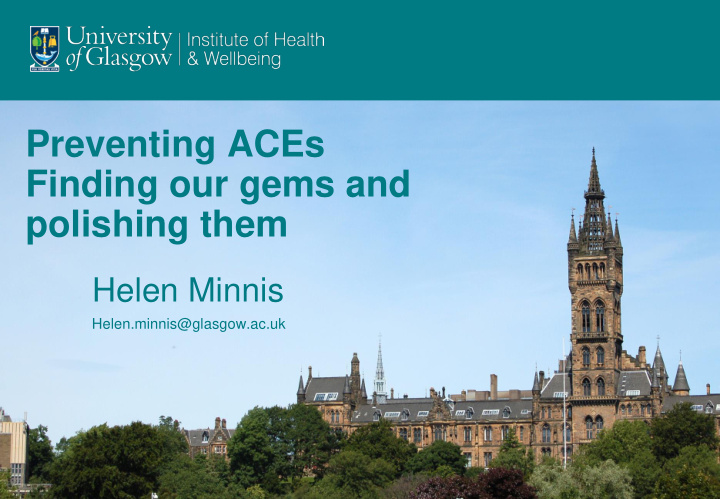



Preventing ACEs Finding our gems and polishing them Helen Minnis Helen.minnis@glasgow.ac.uk
Adverse Childhood Experiences Felitti et al
The ACES load…
Maltreatment-associated psychiatric problems (MAPP) • In adopted children with a history of ACEs in early childhood and indiscriminate friendliness (a specific sign of maltreatment)… – Complex overlapping problems were the norm – Often these were neurodevelopmental problems, not usually thought to be caused by maltreatment – Attachment disorders were common but any diagnosis was possible e.g. Conduct disorder, Tics, ASD, ADHD, PTSD
Background ADHD ASD ODD Childhood LD TD Maltreatment ? ADHD ASD Not maltreated Dinkler et al 2013 www.gnc.gu.se Kocovska et al. 2012, Minnis et al. 2013 6
Research Questions • Is child maltreatment a risk factor for an increased NDD load when controlling for familial effects? ? Childhood Maltreatment www.gnc.gu.se 7
The CATSS twins • born July 1998 - December 2005 in Sweden • N = 13,052 (49.6% females) aged 9 • all data parent-reported • measure of child maltreatment • measure of neurodevelopmental problems www.gnc.gu.se 8
Mean number of neurodevelopmental disorders p = <.001, r = .24 www.gnc.gu.se 9
Results RQ 1: Do children exposed to CM have increased co-occurring NDPs compared to children unexposed to CM? www.gnc.gu.se 10
Results ? ? ? ? 11
Results • a 12
Tdesign? Childhood Maltreatment www.gnc.gu.se 13
Childhood Maltreatment Genetic Factors www.gnc.gu.se 14
Maltreatment-associated psychiatric problems (MAPP) • Complex and often comorbid • Associated with maltreatment • Not caused by maltreatment • The disorder (not the child) could have evoked maltreatment in an already stressed parent who may also have neurodevelopmental problems
Maltreatment-associated psychiatric problems (MAPP) Implications • All maltreated children should be assessed carefully for neurodevelopmental disorders • Children and adults with ”trauma related” disorders should be assessed for neurodevelopmental disorders Where are these • Treatment of neurodevelopmental children in the disorders in adults might prevent population? maltreatment
Prevalence of Attachment Disorders in North Glasgow Phase 1: Questionnaires 1700 children Phase 2:In-depth Assessments with Parents Phase 3: face to Minnis et al 2013 face with children
Prevalence of Attachment Disorders in North Glasgow Phase 1: Questionnaires 1700 children 99% teachers 70% parents Phase 2:In-depth Assessments with Parents Phase 3: face to 23 DSED face with children or RAD
Of those children with an Attachment Disorder: • ALL had at least one other diagnosis • ADHD (54%) • ODD (23%) • CD (31%) 1.4% • PTSD (15%) • ASD (15%) • Tics – 1 child
Completing assessments with these families was challenging, with some receiving up to 12 phone calls and 12 home visits after giving consent in order to complete an assessment.
How do we treat problems and prevent more ACEs_ The most effective intervention is loving family care: • Children who grew up in terrible conditions in Caucescu’s Romania had psychiatric and cognitive problems that resolved almost completely once adopted to the UK O’Connor and Rutter • Trial evidence has shown that changes to cortisol profile can be reversed with “extra nurturing” care Dozier et al
Is introducing a mental health service for maltreated infants a cost-effective way of improving their mental health?
Treatment of birth family with aim to reduce future ACES and improve child mental health – apparently successful in US in non-randomised study
If we open clinic doors to these children, will there be a Tsunami? No. There were only 23 out of 1700 6 and 7 year olds
To find and polish our gems... Each of these children is precious ...and we will need to put a lot of effort in to find them
To find and polish our gems... CAMHS School- assertive health outreach Screening Voluntary Social work sector Casework Self referral
Recommend
More recommend